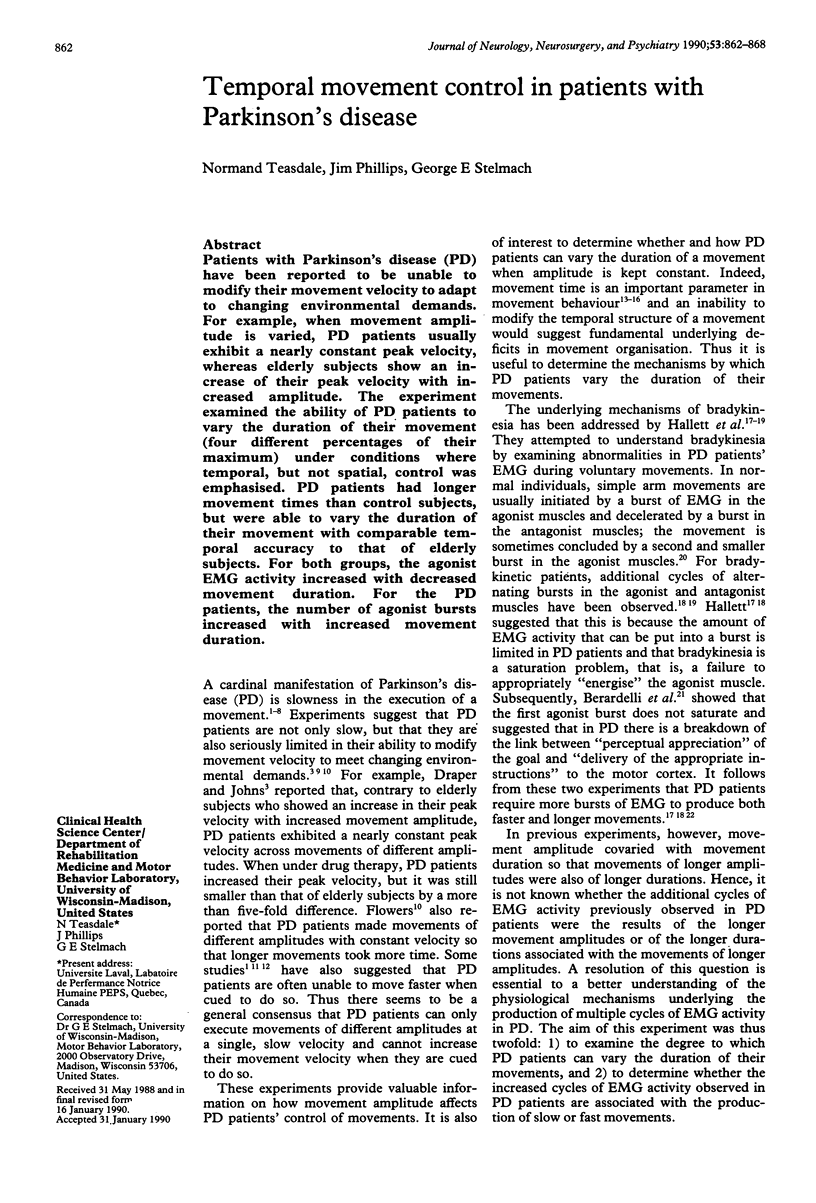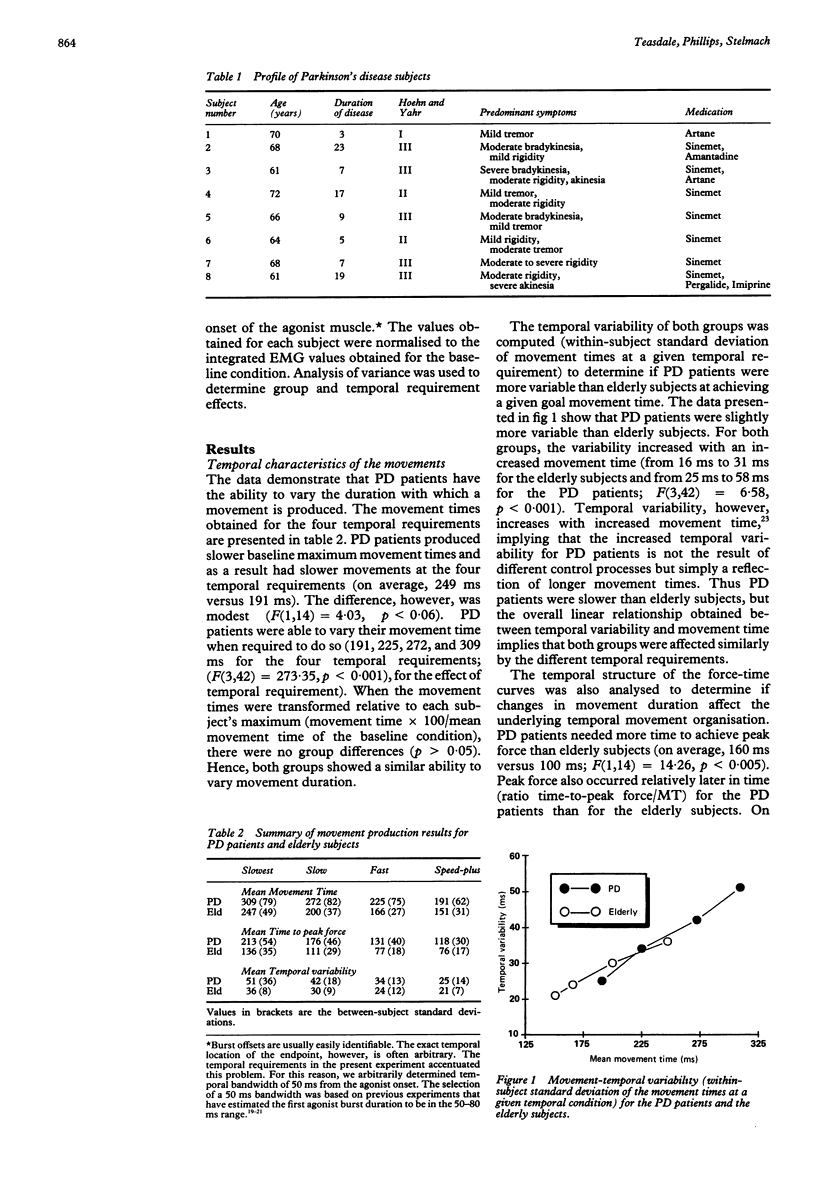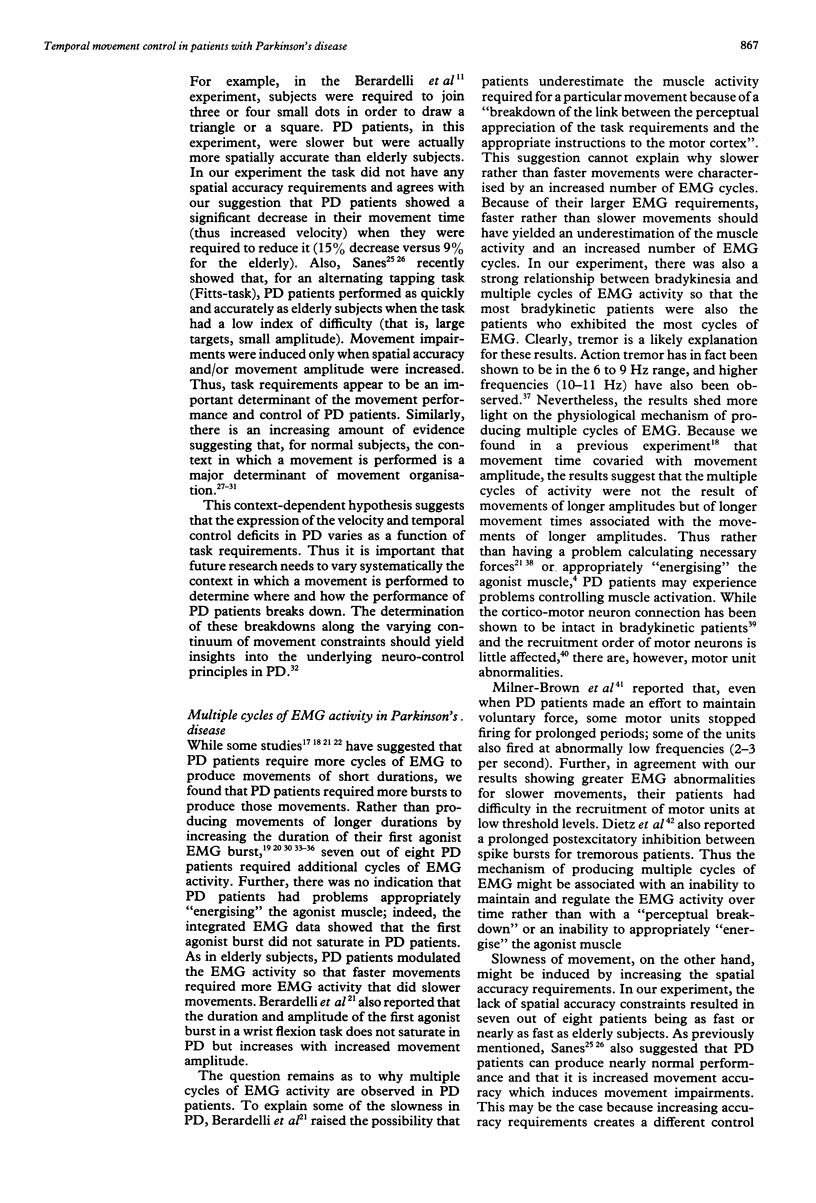Abstract
Patients with Parkinson's disease (PD) have been reported to be unable to modify their movement velocity to adapt to changing environmental demands. For example, when movement amplitude is varied, PD patients usually exhibit a nearly constant peak velocity, whereas elderly subjects show an increase of their peak velocity with increased amplitude. The experiment examined the ability of PD patients to vary the duration of their movement (four different percentages of their maximum) under conditions where temporal, but not spatial, control was emphasised. PD patients had longer movement times than control subjects, but were able to vary the duration of their movement with comparable temporal accuracy to that of elderly subjects. For both groups, the agonist EMG activity increased with decreased movement duration. For the PD patients, the number of agonist bursts increased with increased movement duration.
Full text
PDF






Selected References
These references are in PubMed. This may not be the complete list of references from this article.
- Baroni A., Benvenuti F., Fantini L., Pantaleo T., Urbani F. Human ballistic arm abduction movements: effects of L-dopa treatment in Parkinson's disease. Neurology. 1984 Jul;34(7):868–876. doi: 10.1212/wnl.34.7.868. [DOI] [PubMed] [Google Scholar]
- Berardelli A., Accornero N., Argenta M., Meco G., Manfredi M. Fast complex arm movements in Parkinson's disease. J Neurol Neurosurg Psychiatry. 1986 Oct;49(10):1146–1149. doi: 10.1136/jnnp.49.10.1146. [DOI] [PMC free article] [PubMed] [Google Scholar]
- Berardelli A., Dick J. P., Rothwell J. C., Day B. L., Marsden C. D. Scaling of the size of the first agonist EMG burst during rapid wrist movements in patients with Parkinson's disease. J Neurol Neurosurg Psychiatry. 1986 Nov;49(11):1273–1279. doi: 10.1136/jnnp.49.11.1273. [DOI] [PMC free article] [PubMed] [Google Scholar]
- Bloxham C. A., Mindel T. A., Frith C. D. Initiation and execution of predictable and unpredictable movements in Parkinson's disease. Brain. 1984 Jun;107(Pt 2):371–384. doi: 10.1093/brain/107.2.371. [DOI] [PubMed] [Google Scholar]
- Carter M. C., Shapiro D. C. Control of sequential movements: evidence for generalized motor programs. J Neurophysiol. 1984 Nov;52(5):787–796. doi: 10.1152/jn.1984.52.5.787. [DOI] [PubMed] [Google Scholar]
- DRAPER I. T., JOHNS R. J. THE DISORDERED MOVEMENT IN PARKINSONISM AND THE EFFECT OF DRUG TREATMENT. Bull Johns Hopkins Hosp. 1964 Dec;115:465–480. [PubMed] [Google Scholar]
- Dick J. P., Cowan J. M., Day B. L., Berardelli A., Kachi T., Rothwell J. C., Marsden C. D. The corticomotoneurone connection is normal in Parkinson's disease. Nature. 1984 Aug 2;310(5976):407–409. doi: 10.1038/310407a0. [DOI] [PubMed] [Google Scholar]
- Dietz V., Hillesheimer W., Freund H. J. Correlation between tremor, voluntary contraction, and firing pattern of motor units in Parkinson's disease. J Neurol Neurosurg Psychiatry. 1974 Aug;37(8):927–937. doi: 10.1136/jnnp.37.8.927. [DOI] [PMC free article] [PubMed] [Google Scholar]
- Evarts E. V., Tanji J. Gating of motor cortex reflexes by prior instruction. Brain Res. 1974 May 17;71(2-3):479–494. doi: 10.1016/0006-8993(74)90992-5. [DOI] [PubMed] [Google Scholar]
- Evarts E. V., Teräväinen H., Calne D. B. Reaction time in Parkinson's disease. Brain. 1981 Mar;104(Pt 1):167–186. doi: 10.1093/brain/104.1.167. [DOI] [PubMed] [Google Scholar]
- Flowers K. A. Visual "closed-loop" and "open-loop" characteristics of voluntary movement in patients with Parkinsonism and intention tremor. Brain. 1976 Jun;99(2):269–310. doi: 10.1093/brain/99.2.269. [DOI] [PubMed] [Google Scholar]
- Hallett M., Shahani B. T., Young R. R. Analysis of stereotyped voluntary movements at the elbow in patients with Parkinson's disease. J Neurol Neurosurg Psychiatry. 1977 Dec;40(12):1129–1135. doi: 10.1136/jnnp.40.12.1129. [DOI] [PMC free article] [PubMed] [Google Scholar]
- Hallett M., Shahani B. T., Young R. R. EMG analysis of stereotyped voluntary movements in man. J Neurol Neurosurg Psychiatry. 1975 Dec;38(12):1154–1162. doi: 10.1136/jnnp.38.12.1154. [DOI] [PMC free article] [PubMed] [Google Scholar]
- Heilman K. M., Bowers D., Watson R. T., Greer M. Reaction times in Parkinson disease. Arch Neurol. 1976 Feb;33(2):139–140. doi: 10.1001/archneur.1976.00500020067011. [DOI] [PubMed] [Google Scholar]
- Marteniuk R. G., MacKenzie C. L., Jeannerod M., Athenes S., Dugas C. Constraints on human arm movement trajectories. Can J Psychol. 1987 Sep;41(3):365–378. doi: 10.1037/h0084157. [DOI] [PubMed] [Google Scholar]
- Marteniuk R. G., MacKenzie C. L., Jeannerod M., Athenes S., Dugas C. Constraints on human arm movement trajectories. Can J Psychol. 1987 Sep;41(3):365–378. doi: 10.1037/h0084157. [DOI] [PubMed] [Google Scholar]
- Milner-Brown H. S., Fisher M. A., Weiner W. J. Electrical properties of motor units in Parkinsonism and a possible relationship with bradykinesia. J Neurol Neurosurg Psychiatry. 1979 Jan;42(1):35–41. doi: 10.1136/jnnp.42.1.35. [DOI] [PMC free article] [PubMed] [Google Scholar]
- Mustard B. E., Lee R. G. Relationship between EMG patterns and kinematic properties for flexion movements at the human wrist. Exp Brain Res. 1987;66(2):247–256. doi: 10.1007/BF00243302. [DOI] [PubMed] [Google Scholar]
- Sanes J. N. Information processing deficits in Parkinson's disease during movement. Neuropsychologia. 1985;23(3):381–392. doi: 10.1016/0028-3932(85)90024-7. [DOI] [PubMed] [Google Scholar]
- Schmidt R. A., Sherwood D. E., Walter C. B. Rapid movements with reversals in direction. I. The control of movement time. Exp Brain Res. 1988;69(2):344–354. doi: 10.1007/BF00247579. [DOI] [PubMed] [Google Scholar]
- Schmidt R. A., Sherwood D. E., Walter C. B. Rapid movements with reversals in direction. I. The control of movement time. Exp Brain Res. 1988;69(2):344–354. doi: 10.1007/BF00247579. [DOI] [PubMed] [Google Scholar]
- Shapiro D. C., Walter C. B. An examination of rapid positioning movements with spatiotemporal constraints. J Mot Behav. 1986 Dec;18(4):373–395. doi: 10.1080/00222895.1986.10735387. [DOI] [PubMed] [Google Scholar]
- Shapiro D. C., Walter C. B. An examination of rapid positioning movements with spatiotemporal constraints. J Mot Behav. 1986 Dec;18(4):373–395. doi: 10.1080/00222895.1986.10735387. [DOI] [PubMed] [Google Scholar]
- Sheridan M. R., Flowers K. A., Hurrell J. Programming and execution of movement in Parkinson's disease. Brain. 1987 Oct;110(Pt 5):1247–1271. doi: 10.1093/brain/110.5.1247. [DOI] [PubMed] [Google Scholar]
- Soechting J. F. Effect of target size on spatial and temporal characteristics of a pointing movement in man. Exp Brain Res. 1984;54(1):121–132. doi: 10.1007/BF00235824. [DOI] [PubMed] [Google Scholar]
- Soechting J. F. Effect of target size on spatial and temporal characteristics of a pointing movement in man. Exp Brain Res. 1984;54(1):121–132. doi: 10.1007/BF00235824. [DOI] [PubMed] [Google Scholar]
- Stelmach G. E., Worringham C. J., Strand E. A. Movement preparation in Parkinson's disease. The use of advance information. Brain. 1986 Dec;109(Pt 6):1179–1194. doi: 10.1093/brain/109.6.1179. [DOI] [PubMed] [Google Scholar]
- Stelmach G. E., Worringham C. J., Strand E. A. The programming and execution of movement sequences in Parkinson's disease. Int J Neurosci. 1987 Sep;36(1-2):55–65. doi: 10.3109/00207458709002139. [DOI] [PubMed] [Google Scholar]
- Stelmach G. E., Worringham C. J. The preparation and production of isometric force in Parkinson's disease. Neuropsychologia. 1988;26(1):93–103. doi: 10.1016/0028-3932(88)90033-4. [DOI] [PubMed] [Google Scholar]
- Teasdale N., Stelmach G. E. Movement disorders: the importance of the movement context. J Mot Behav. 1988 Jun;20(2):186–191. doi: 10.1080/00222895.1988.10735442. [DOI] [PubMed] [Google Scholar]
- Teräväinen H., Calne D. B. Action tremor in Parkinson's disease. J Neurol Neurosurg Psychiatry. 1980 Mar;43(3):257–263. doi: 10.1136/jnnp.43.3.257. [DOI] [PMC free article] [PubMed] [Google Scholar]
- Traub M. M., Rothwell J. C., Marsden C. D. A grab reflex in the human hand. Brain. 1980 Dec;103(4):869–884. doi: 10.1093/brain/103.4.869. [DOI] [PubMed] [Google Scholar]
- Wallace S. A., Wright L. Distance and movement time effects on the timing of agonist and antagonist muscles: a test of the impulse-timing theory. J Mot Behav. 1982 Dec;14(4):341–352. doi: 10.1080/00222895.1982.10735284. [DOI] [PubMed] [Google Scholar]
- Waters P., Strick P. L. Influence of 'strategy' on muscle activity during ballistic movements. Brain Res. 1981 Feb 23;207(1):189–194. doi: 10.1016/0006-8993(81)90692-2. [DOI] [PubMed] [Google Scholar]


